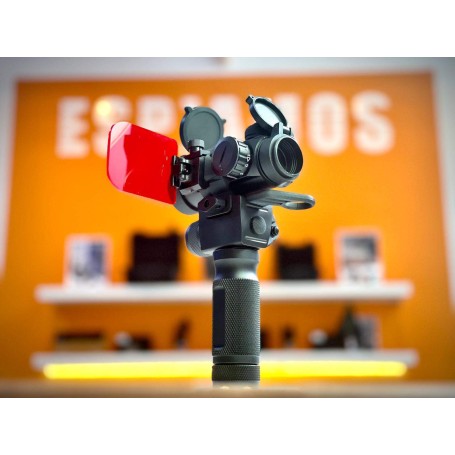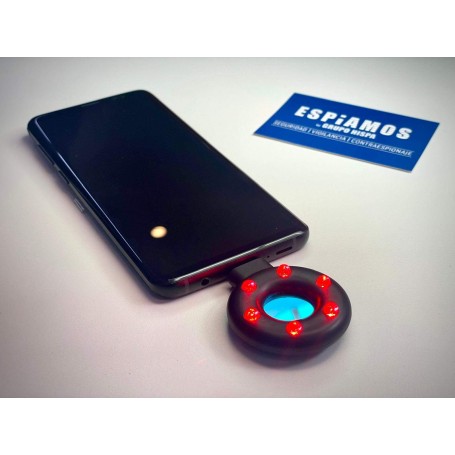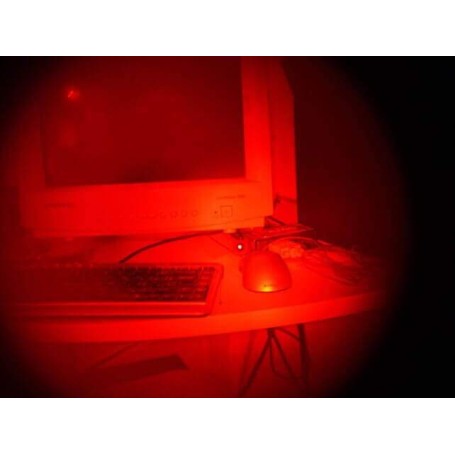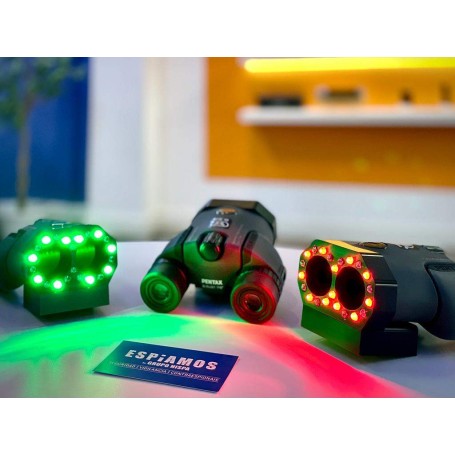Detecting hidden cameras in difficult spaces is a challenge that requires specialized techniques and advanced tools to ensure security and privacy. As spy cameras become smaller and easier to hide, the methods for finding them have also evolved, providing users with efficient solutions for all types of environments, from offices and hotels to vehicles or residences. In this article, we will explore how to detect hidden cameras in areas where their placement is more complex and what tools and strategies can help you protect your privacy.
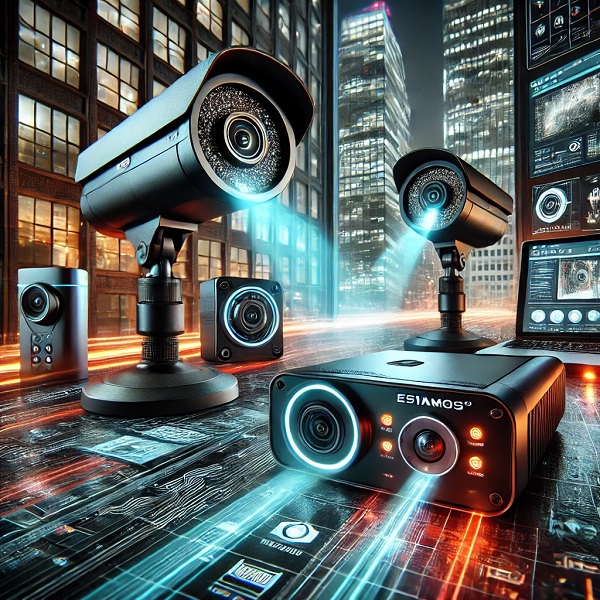
Table of Contents
- Why is it important to detect hidden cameras in difficult spaces?
- Common challenges when searching for hidden cameras in difficult spaces
- Strategies and tools to detect cameras in complex places
- Best hidden camera detectors for difficult areas
- Conclusion
- Frequently Asked Questions
Why is it important to detect hidden cameras in difficult spaces?
The growing concern for privacy in the digital age has led many people to worry about the presence of hidden cameras in places where they expect privacy. Hotels, rental apartments, private offices or even vehicles can be targets for unwanted surveillance. Detecting hidden cameras in difficult spaces becomes crucial, as these places are the most vulnerable and, by their nature, make direct visual access or a cursory inspection difficult.
Spying and invasion of privacy are not just problems for celebrities or high-profile people, but also for ordinary individuals who can be targeted for surveillance in their everyday lives. Cameras can be hidden in unusual places such as electrical outlets, wall clocks, smoke detectors or even inside everyday objects, making them much more difficult to locate in these spaces.
For this reason, it is essential to be aware of the most advanced methods and have the right tools to ensure that your privacy is always protected. With the appropriate camera detectors and techniques, you can turn these difficult spaces into safe areas for you and your loved ones.
Common challenges when searching for hidden cameras in difficult spaces
Difficult spaces present several challenges when it comes to detecting hidden cameras, as they are often located in places that make a traditional inspection difficult. Here are some of the main obstacles you may face:
1. Irregular surfaces and multiple objects
Spy cameras are often hidden among everyday objects, making them virtually invisible to the naked eye. In spaces like offices or cluttered rooms, the sheer number of items in the room makes it difficult to locate a small recording device. Hidden cameras in clocks, picture frames, USB chargers, or smoke detectors are very common, and because they are surrounded by similar objects, it is easy for them to go unnoticed.
2. Areas with poor lighting
Lack of light is one of the main problems when it comes to detecting hidden cameras. Spaces such as basements, attics or rooms without windows can become areas where visibility is minimal, which favors the installation of cameras that capture images without being detected. Fortunately, there are tools equipped with LED lighting or infrared vision that allow these dark areas to be inspected without problems.
3. Recessed elements and small gaps
One of the most common techniques for hiding cameras is to integrate them into fixed objects such as walls, ceilings or furniture. This complicates detection, as the devices can be placed in small openings, cracks or even behind a transparent surface, such as the glass of a smoke detector. Locating cameras in these spaces requires advanced technical knowledge and the use of specialized equipment that can detect the camera optics through light reflection.
4. Wireless transmission technology
Many modern hidden cameras do not require wires to transmit images, making them even more difficult to locate. These devices can send recordings via Wi-Fi or Bluetooth signals, eliminating the need to be physically connected to a recorder or monitor. The absence of wires makes them more difficult to detect, especially in large spaces or with multiple areas where they can be hidden.
Strategies and tools to detect cameras in complex places
Overcoming the above challenges requires a strategic approach and the use of specific tools to ensure successful detection. Below are some key strategies you can apply to detect hidden cameras in difficult spaces:
1. Detailed visual inspection
The first step should always be a thorough visual inspection of the suspicious area. Closely examine objects such as clocks, mirrors, picture frames, plants, or any other items that may seem out of place or poorly positioned. Most cameras need a direct line of sight to record, so any device pointed at you could be a suspicious target.
2. Using hidden camera detectors
Hidden camera detectors are indispensable tools for locating spy devices, as they can pick up the reflection of hidden camera lenses or detect transmission signals. In difficult spaces, it is advisable to use detectors with laser or infrared technology that can identify cameras even in low light conditions or when they are integrated into irregular surfaces.
3. Verification of electronic devices
In closed or highly-monitored spaces, a good strategy is to check electronic devices for hidden cameras. Electrical outlets, USB chargers, and common-looking electronic equipment are some of the favorite places to hide spy cameras. There are specialized devices that can detect the frequencies emitted by hidden cameras that use Wi-Fi or Bluetooth to transmit data.
Best hidden camera detectors for difficult areas
When it comes to detecting hidden cameras in difficult spaces, it's not just a matter of strategy, but also having the right tools to make the search easier and increase the chances of success. Below, we present a selection of the best lens detectors for complex situations, which will help you ensure privacy in all types of environments.
1. Professional laser spy camera detector
This device is ideal for inspections in spaces with limited lighting or irregular surfaces. Its laser technology allows the detection of the smallest cameras by light reflection. In addition, its aluminum construction makes it a robust and portable tool, perfect for professional or personal use. Thanks to its infrared flash frequency, it allows the identification of hidden camera lenses through red light filters, increasing accuracy even in low visibility conditions.
2. Compact Lens Detector with USB-C connection
Designed to connect directly to Android phones via a USB-C port, this detector is a lightweight and portable option for users who require easy-to-carry equipment. Although its size is compact, it is equipped with powerful LED lights and an infrared filter to locate hidden cameras in any type of environment. Its main advantage is that it does not need a battery, as it is powered directly from the smartphone, making it always available for quick inspections in hard-to-reach spaces.
3. Hidden camera detector with advanced infrared filter
This device uses an advanced infrared filter that allows it to locate spy cameras, even those protected with special optical filters. Its ergonomic design and the incorporation of an adjustable focus system make it ideal for detecting hidden cameras in difficult spaces, such as high ceilings or areas with many objects. In addition, its adjustable LED lighting and its ability to detect cameras at distances of up to 25 meters make it an indispensable tool in environments where discretion is key.
4. Camera detector with LCD screen
This detector features an LCD screen that allows you to view any detected cameras in real time. It is ideal for inspecting larger or more complex spaces, as its advanced technology can pick up camera signals through thin walls or furniture. The combination of its visual interface and its ability to detect cameras with wireless transmission makes it one of the best devices for difficult spaces where a manual inspection would be ineffective.
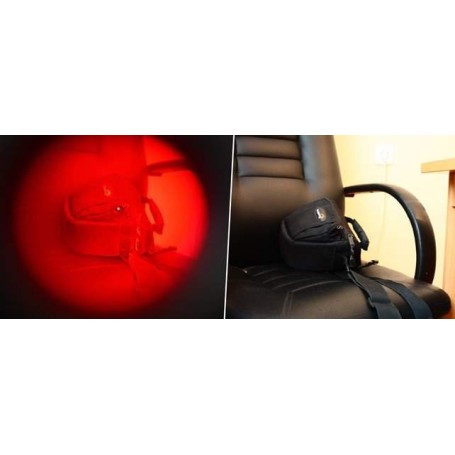
5. Portable detector with magnifying lens
Equipped with a magnifying lens and a green light filter, this detector is perfect for examining small objects and areas that are difficult to visually inspect. Its ability to increase the visibility of hidden lenses in everyday objects makes it an effective tool for detecting cameras in tight spaces or among many items, such as shelves full of books or furniture drawers.
Conclusion
Detecting hidden cameras in difficult spaces can seem like a daunting task, but with the right tools and a strategic approach, it is possible to ensure privacy in any environment. From professional laser detectors to handheld devices connected to smartphones, there are a variety of options to suit different needs and situations. Choosing the right detector will depend on the type of space and level of security you are looking for.
At ESPIAMOS®, we have a wide selection of hidden camera detectors that will provide you with the security and peace of mind you need. By using the most advanced devices on the market, you can ensure that your privacy is protected at all times, regardless of the difficulties presented by the environment.
Frequently Asked Questions (FAQ)
1. How do hidden camera detectors work?
Hidden camera detectors work by detecting the reflection of light on the camera lens or by picking up the transmission signals emitted by cameras, even when they are turned off. They use laser or infrared technology to highlight hidden lenses, allowing them to be located in difficult spaces.
2. Is it possible to detect hidden cameras without a specialized detector?
While it is possible to visually inspect an area for hidden cameras, the use of a specialized detector greatly increases the chances of success, especially in difficult or limited-light spaces. These devices are designed to identify cameras that would be virtually impossible to detect with the naked eye.
3. Do hidden camera detectors work in the dark?
Yes, many detectors are equipped with LED or infrared lights that allow them to operate in low-light or total darkness conditions. Some advanced models even feature screens that display real-time images, making it easier to locate hidden cameras in low-visibility environments.
4. What are the main differences between professional camera detectors and compact detectors?
Professional detectors typically have a longer range, advanced features such as real-time viewing, and the ability to detect hidden cameras through materials such as walls or furniture. Compact detectors, on the other hand, are more portable and designed for quick inspections, although they have less range and features.
5. How do I choose the best camera detector for my needs?
Choosing the best detector depends on the type of space and your specific needs. If you need to inspect large areas or complex spaces, a professional detector with an LCD display and a long range would be the best choice. For situations where portability is essential, a compact detector or one that connects to your smartphone may be more practical.
6. Is it difficult to use a hidden camera detector in small or complicated spaces?
No, most hidden camera detectors are designed to be easy to use, even in tight spaces or with lots of objects. Many devices feature magnifying lenses or infrared filters that make it easier to locate cameras in areas that are difficult to inspect manually.
7. Can I use a hidden camera detector to protect my home or rental property?
Yes, hidden camera detectors are effective tools for ensuring privacy in your home or rental properties such as apartments or hotel rooms. By conducting regular inspections with these devices, you can ensure that hidden cameras are not being used without your consent.
8. Can hidden camera detectors detect wireless cameras?
Yes, many detectors are equipped to detect both wired and wireless cameras. Some advanced devices can also detect cameras that are turned off or in standby mode by making their lens visible through the reflection of infrared light.
9. What is the maximum detection distance of a hidden camera detector?
The maximum detection distance varies depending on the detector model. Some advanced devices can locate hidden cameras at distances of up to 25 meters, while others are designed for short-range inspections in tighter spaces. It's important to choose a detector that suits your needs and the type of space you want to inspect.
10. Do I need technical knowledge to use a hidden camera detector?
No, most hidden camera detectors are designed to be used by anyone, with no prior technical experience required. They are equipped with intuitive and easy-to-use controls, allowing any user to perform effective inspections without complications.
Conclusion
Detecting hidden cameras in difficult spaces is a task that requires the right tools and an effective strategy. Hidden camera detectors available on the market have evolved considerably, offering practical solutions for both professional users and those who wish to protect their privacy in everyday environments.
When selecting the best detector for your needs, it is essential to consider the key features of each device, such as detection capacity, ease of use, and the environment you plan to use it in. From compact smartphone-connected devices to advanced laser-powered detectors, there is an option available for every situation.
At ESPIAMOS®, we offer you a wide range of hidden camera detectors that will provide you with the security you need in any space, be it a home, office or rental property. With these devices, you can be sure that your privacy is protected, even in the most challenging environments.






 WhatsApp
WhatsApp Telegram
Telegram



